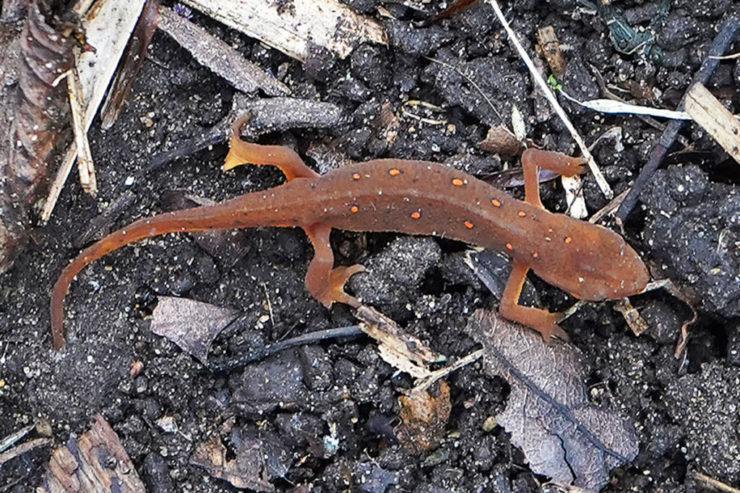Charlestown Creature Feature: Red-Spotted Newt
Red-Spotted Newts are a species of salamander that are found throughout Rhode Island but are more common in Charlestown and other Western parts of the state. They are Amphibians and need to live in moist areas to survive.
As larvae and adults, they inhabit ponds. During their terrestrial, eft stage, they inhabit moist forests. Their eggs are secured to aquatic vegetation and hatch between May and September. Larvae take several months before they metamorphose into a terrestrial “eft” stage in late summer or early fall. Efts live on land and can take up to 7 years to fully mature. Adult newts and mature efts migrate to breeding ponds around March and April, where mature efts metamorphose into their aquatic adult form.
Breeding occurs in early spring; some newts remain in breeding ponds throughout the summer and others move onto land to rest under leaf litter. It is believed newts spend the winter inactive on land, if their water source is not permanent. If their water source is permanent, they may overwinter in the water.
Their diet consists of insects, small crustaceans, mollusks, fish, fish and frog eggs and worms. The Red-Spotted Newt help to control mosquito populations by eating their larvae.
The biggest threat that newts and other salamanders face is habitat loss and fragmentation. Their habitats need to be connected to allow them to access the resources they require. Fragmentation increases mortality as they attempt to cross roads to reach isolated sources of food, shelter and breeding ponds.
Red-Spotted Newts, like other salamanders, are considered indicator species, meaning the health of their populations tell us about the health of the environment in general.
Photo by Cliff Vanover of a Red-Spotted Newt during its terrestrial “eft” stage in a Charlestown garden.
Newt information from Amphibians of Rhode Island by Christopher Raithel

November 9, 2020 @ 4:38 pm
Wow, thanks for all that good info! Have never even seen one and have been living and gardening in Charlestown since 1999 at 3 different homes using leaves / compost, sustainable garden practices.
Since we are on the subject of species and critters, I am still seeing monarch butterflies which is amazing since we have already had freezing temps and snow! They love and need goldenrod and asters this time of year as most of their other food supply has “ gone by” I have seen them nectaring on dandelions as well. So reconsider what you consider “ weeds” in your grass and allow some of these essentials for nature’s banquet!
Also, remember migrating birds need a dark sky to navigate so don’t feel like you need to keep on lots of lights outside !!! Plus its nice to see the stars here in our town, which is harder to do when everyone around you has big porch and landscape lights .
November 8, 2020 @ 5:07 pm
Thank you for posting about newts. The interaction between species is an intricate pattern. There is a lot we don’t know about what is beneath our feet and the little creatures that contribute to the forests and farms.There are other threats to amphibians too – diseases especially in frogs; drying out of leaf litter because amphibians need to keep their skin moist as temperatures increase or droughts occur; large non native worms like night crawlers that are too big for them, especially salamanders, to eat and that eat the leaf litter they rely on. There are no really native earthworms in RI as the glaciers eradicated any. What are here have been introduced for gardening, fishing, and other reasons or introduced accidentally. They do recycle the leaves and make for better soil but many native woodland wildflowers also rely on the leaf litter for their seed germination and many small invertebrates rely on it for cover and moisture and are adapted to the normal soil and leaf litter conditions. These large worms may be changing the soil and leaf litter in forests and moving further into them. It is important to retain some more natural forests so that the vital species that are there do not disappear.